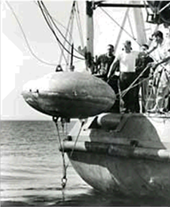Project Mohole |
 |
 |
 |
|
The vision and reality of deep ocean drilling began in 1961 with Project Mohole. Project Mohole led by the American Miscellaneous Society with funding from the National Science Foundation, was an ambitious attempt to drill through the Earth's crust into the Mohorovicic discontinuity and to provide an Earth science complement to the high profile Space Race. Project Mohole contracted with Global Marine of Los Angeles for the use of its oil drillship called CUSS I. Consortia of Continental, Union, Superior and Shell Oil Companies (CUSS) had originally developed the drillship in 1956 as a technological test bed for nascent offshore oil capable of drilling in water depth up to 600 ft, Project Mohole expanded its operational range by virtually inventing what is now known as dynamic positioning. Phase One was executed in the spring of 1961. Off the coast of Guadalupe, Mexico, five holes were drilled, the deepest at 183m (601 ft) below the sea floor in 3,500 m (11,700 ft) of water. This was unprecedented: not in the hole's depth but because of the depth of the ocean and because it was drilled from an untethered platform. Also, the core sample proved quite valuable, showing Miocene age sediments with the lowest 13 m (44 ft) consisting of basalt. Phase One proved that both the technology and expertise were available to drill into the Earth's mantle.However, Mohole-Phase Two was dissolved in 1966 for budgetary reasons.
|
IODP Photo Gallery









